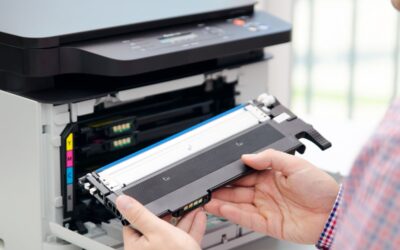Less than 45% of IT professionals address print security at their organizations or take steps to address printer security. In today’s digital world, it’s critical that recognize the security threats associated with network printing.
VIDEO: Print Security Tips
Printers are more like computers than ever before, making them an easy attack option for cybercriminals.
Business owners and IT leaders must make secure print solutions a top priority. Execute these five secure printing tips to ensure proper print security for your organization.

1. Effectively Manage Your Users
If you do anything, it should be managing your employees. Your employees represent the most significant security threat. Over 90% of security breaches are the result of human error. Your employees represent a significant security threat.
Employees aren’t malicious. It’s just easy to make mistakes like:
- Printing a confidential document and leaving it to sit on the printer.
- Even on private printers, printer memory storage will store confidential documents. Without the proper security, these documents can be infiltrated.
To ensure employees print securely, you must train and educate them on the procedures they must follow when printing. Education helps them understand the risks. When they know why printer security matters, they’ll be more likely to practice it.
Access is equally essential to education. You must manage who has access to the different printers in your fleet. Be sure to create accounts with specific printing privileges. Team members who print confidential documents require special clearance and tracking parameters.
2. Invest in Your Hardware
Once you have the team properly educated and tracked, your next step is securing the printer itself. Do you know where each copier MFP Printer on your network was acquired? If you’re renting equipment, this is especially important.
Understand the security features of each device in your printing fleet. Current models come with security features designed to protect your network. Leverage your corporate firewall by only allowing trusted IPs to connect to your multifunction printers and limit printing to your local network.
As already mentioned, documents are stored in the printer’s memory. Modern printers have security settings that let you erase confidential documents from memory. If your printers don’t have these security features, you should seriously consider upgrading your equipment.
Finally, don’t forget where you locate your devices – place printers in easily watchable locations to track who is accessing the equipment more effectively.
3. Leverage Proper Software
There are fantastic software tools specifically designed to monitor and secure your print environment. These tools can be more cost-effective than simply purchasing individual private printers for printing confidential or sensitive information.
Software tools permit employees to share a printer with others while maintaining security. Secure print software has settings that put print jobs into a holding pattern by requiring the user to input an access code or PIN at the copier MFP printer, triggering the device to print. This feature prevents documents from being left on the device, where anyone can see or take them.
4. Regularly Update & Patch Software
Tracking security for the Software you run on your network (computers, printers, mobile devices, etc.) is critically important. Do you have processes in place to complete network vulnerability assessments?
You must regularly check for security updates and patch those vulnerabilities regularly. Many organizations do this as a standard operating procedure on employee computers, but many neglect to run this same process on their fleet of printers. You can not afford to miss this step.
If you haven’t already, integrate your printers and other hardware into corporate security protocols. The more potential access points you can secure, the safer your business.
5. It’s Okay To Ask for Help
Cybersecurity is rapidly changing and growing. We collectively face this accelerating challenge, and most IT teams and business owners struggle to manage security. As more devices are added to the network, controlling all the access points becomes more challenging.
This situation is likely why copier MFP printers are often overlooked. They seem low-risk compared to other devices, and the IT team has to prioritize their time to manage the constantly evolving infrastructure.
It’s okay to ask for help. Using a third-party provider can improve your printer security and your business overall.
Finding an expert partner (like BDS) can help you scope the perfect mix of security features and software to protect your business and optimize ROI. Additionally, they can help you securely integrate printers into the network and provide assistance with monitoring and patching.
Secure Printing Wrap Up
We hope this blog provides a clear picture of why secure print solutions are necessary for your business. Follow these five vital steps to make your printers and your network more secure.
If you need help, we’d love to speak with you. BDS has 40+ years of experience.
About BDS:
We recognize the changing scope of Office Document Technology in today’s workforce. Our mission has never wavered – bring excellence to every facet of the customer experience, creating a truly unique and unparalleled partnership. Your advanced copying, printing, scanning, and document management require a custom-tailored approach to meet the needs of your business. We assess document workflow needs by implementing analysis processes utilizing data collection agents and a customized systems audit process to determine the best practices for your office. We have the expertise to help you design a solution that fits your business.






